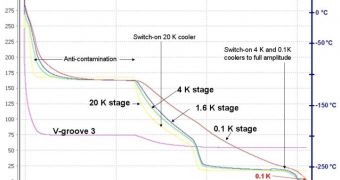The level of complexity at which Planck does its science never failed to amaze anyone looking deeper into its capabilities. In addition to the peculiar point in space where its orbit lies, at the Lagrangian point 2, some 1.5 million kilometers away from us, it also features another remarkable trait – it's cooled at nearly absolute zero, so as to facilitate its scientific observations. And when engineers first thought of a cool telescope, they meant it. The craft is only 0.1 degrees Celsius warmer than absolute zero. This essentially makes the Planck Space Telescope the coldest object in the known Universe.
Such extremely low temperatures are necessary for the satellite's very complex and sensitive instruments, which need to be able to study the Cosmic Microwave Background (CMB) of the Universe. The CMB is a remnant of the first light that appeared after the Big Bang, some 13.3 billion years ago, and it's the telescope's purpose to analyze it to such depth that it could provide astronomers with deeper knowledge of the way the early Universe formed and evolved, and also how the current cosmic structure came to be.
Planck’s High Frequency Instrument is the main observation device on the telescope, and it was its detectors that, on July 2nd, reached their optimum functioning temperature. At this point they are cooled at -273.05°C, a fraction of a degree warmer than absolute zero (0°Kelvin, –273.15°C). This low temperature was achieved over three commissioning phases, each of them constructed by a different contractor. At first, passive cooling systems radiated the heat that the craft produced into space, until the entire construct reached about -230 degrees Celsius.
Then, the active cooling mechanisms kicked in, and gradually reduced Planck's temperature to 20°K, 4°K, and 0.1°K, respectively. According to mission controllers at the European Space Agency, all stages of the process went extremely well, and the craft is now essentially ready to begin its actual science mission. By mid-August, they estimate that all fine-tuning of the instrument will be completed, and that the first genuine scientific measurements will be made successfully.

 14 DAY TRIAL //
14 DAY TRIAL //